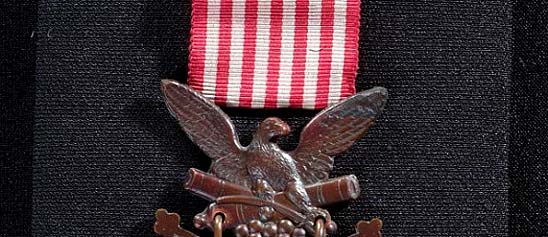Sword: This presentation sword was given to Ulysses S. Grant in April 1862. The blade is long, slender, diamond shaped, and straight. It is decorated with silver chasing on both sides. On the obverse, there is a "US" monogram in the center.
- Description
-
Sword: This presentation sword was given to Ulysses S. Grant in April 1862. The blade is long, slender, diamond shaped, and straight. It is decorated with silver chasing on both sides. On the obverse, there is a "US" monogram in the center. Above the monogram there is a bugler sounding his horn and below it there is a Zouave soldier and an infantryman holding his bayonet. There are floral designs surrounding each of the characters. The reverse is similarly decorated with an infantryman, a Zouave, a naval officer, and trophy and floral designs. The grip of the sword is ivory. On the obverse there is a United States flag and shield design, a Roman helmet, and two crossed cannons. The reverse bears a simple carving of a shingle design. The pommel is shaped like a vase, with an eagle cast on the obverse and a plain shield surrounded by scroll designs on the reverse. There are four faces cast into the top of the pommel: Zeus, Hermes, and two who look like classical soldiers. The knuckleguard is a four sided bronze strip, the obverse and reverse of which are decorated with thunderbolts. It terminates in a round, flat quillon with a floral design cast on the tip. The counterguard is ovular, and features an eagle standing in front of three standards. The reverse side of the counterguard is a plain, and it is hinged to the quillon.
-
Scabbard: The scabbard bears three gold mounts. The top two mounts are decorated in scroll and floral designs, and the bottom, (which acts as the drag), bears a long oak spray. There is an inscription reading, "Genl. U.S. Grant. / GALENA ILL'S" between the top and middle mount on the obverse. The space between the middle mount and the drag bears an engraving of military trophies and floral designs. The reverse of the scabbard bears an inscription reading, "PRESENTED / BY / G.W. Graham. C.B. Lagow. / C.C. Marsh & John Cook. / 1861". The scabbard has three carrying rings, one on each side of the top mount, and one on the right side of the middle mount.
- Location
-
Currently not on view
- date made
-
1861
- date presented
-
1861
- recipient
-
President Ulysses S. Grant
- associated person
-
Graham, G. W.
-
Lagow, C. B.
-
Marsh, C. C.
-
Hook, John
- maker of sword
-
Schuyler, Hartley & Graham
- maker of scabbard
-
Ames Manufacturing Company
- ID Number
-
AF.2989
- catalog number
-
2989
- accession number
-
18528
